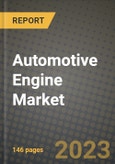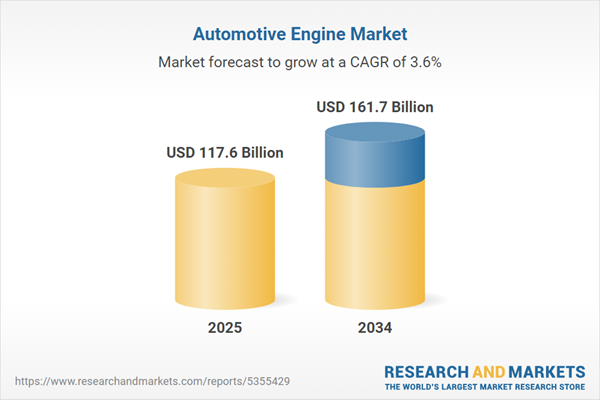Automotive Engine Market
The automotive engine market covers the manufacture and supply of engine units (internal‑combustion, hybrid, and in some respects “engine” analogues for electrified systems) for passenger cars, light‑commercial vehicles, heavy commercial vehicles and two‑wheelers. Engine types span gasoline (spark‑ignition), diesel (compression‑ignition), and increasingly hybridised and alternative‑fuel units (e‑fuel compatible, mild‑hybrid integrated units). Applications focus on propulsion for on‑road vehicles, but also off‑road, industrial and generation‑backup segments in some cases where engine variants overlap. Recent trends reflect intense pressure on emissions, fuel‑efficiency and CO₂ reduction - leading to downsizing (smaller displacement with turbocharging), direct‑injection systems, 48V and higher‑voltage mild hybrid integration, and modular engine families designed to support hybrid and electric powertrains. Concurrently, although full‑battery electric vehicles erode pure ICE volume over time, the engine market remains viable via hybrid/ICE mix, regional combustion demand (emerging markets) and durability growth in aftermarket. Driving factors include global vehicle production growth, especially in emerging economies; regulatory mandates for fuel efficiency and emissions; consumer interest in performance, efficiency and low total cost of ownership; and supplier/upstream consolidation as OEMs seek fewer engine platforms. The competitive landscape features global automakers and tier‑1 powertrain specialists engineering large modular families, alongside component‑suppliers for turbochargers, direct‑injection systems, variable‑valve timing and emissions after‑treatment. Other market overview considerations: price pressure from raw‑materials (steel, aluminium, rare‑earths for electrification); increasing R&D spend on electrified engine integration; risk of substitution as vehicles shift to full‑electric; and regional variation in take‑up due to infrastructure, fuel availability, regulatory timing and consumer preferences.Automotive Engine Market Key Insights
- Downsizing & forced induction dominate design posture
- Hybridisation extends the internal combustion engine lifespan
- Alternative fuels and e fuels create a transition pathway
- Regional divergence is significant
- Modular engine families and shared platforms reduce cost
- Emissions and regulatory pressure reshape engine architectures
- Aftermarket and remanufacturing remain steady state
- Electrification is a substitutive threat rather than an immediate replacement
- Raw material and supply chain cost inflation constrain margins
- Localization and regional production footprint matter
Automotive Engine Market Reginal Analysis
North America
In North America, engine demand is shaped by relatively high per‑vehicle content, strong aftermarket ecosystems (especially for trucks and SUVs), and regulatory drivers (fuel‑efficiency, emissions). There is accelerated uptake of mild‑hybrid and full‑hybrid engines in mainstream models, and continuing development of high‑performance turbocharged engines. The large‑truck segment continues supporting V6/V8 ICE platforms. OEMs maintain significant internal‑combustion engine assembly capacity, but electrification growth provides a contrasting future path.Europe
Europe is highly regulated in terms of CO₂, NOₓ and emissions targets, which drives engine platforms toward high‑efficiency combustion, hybridisation, and alternative‑fuel compatibility (e‑fuels, hydrogen ICE). Engine downsizing, direct injection, mild‑hybrids (48 V) and plug‑in hybrids are common. Emerging markets in Eastern Europe are somewhat slower, but Western Europe leads. The shift toward electrification is more advanced here, creating risk of faster decline in pure‑ICE new‑engine builds.Asia‑Pacific
Asia‑Pacific combines enormous volume growth potential in passenger cars, commercial vehicles and two‑wheelers. Many markets still favour conventional ICE engines due to cost sensitivity, infrastructure constraints and fuel availability. As a result, engine production remains strong for some time. At the same time, OEMs supplying Asia are introducing compact turbocharged engines, small displacement hybrids and export‑oriented powertrains. India, China‑ASEAN region and other emerging hubs are focal points for new engine investment and localisation.Middle East & Africa
The Middle East & Africa region leverages ICE engines heavily, particularly for commercial vehicles, off‑road, agriculture and mining equipment. Engine durability, fuel‑flexibility and adaptation to harsh environments matter. While electrification is slow, regulatory pressure is increasing and some premium vehicle segments are migrating to hybrid powertrains. Localization of engine production is less developed, and import dependence remains.South & Central America
In South & Central America, engine demand is influenced by macro‑economic volatility, currency risk, import tariffs and used‑vehicle fleets. Conventional ICE engines dominate, especially for cost‑sensitive segments. However, global OEMs are starting to introduce downsized, turbo‑charged and hybrid engine strategies even here, albeit at slower pace. Regional production hubs serve both local assembly and export markets, with engines tailored to local fuel grade and emission norms.Automotive Engine Market Segmentation
By Placement
- In line engine
- V type engine
- W- engine
By Fuel
- Gasoline
- Diesel
- Others
By Vehicle
- Passengers Car
- Commercial Vehicle
Key Market players
Toyota Motor, Hyundai Motor Group, Volkswagen Group, Stellantis, General Motors, Ford Motor, Honda Motor, Nissan Motor, BMW Group, Mercedes-Benz Group, Cummins, Caterpillar, Volvo Group, Deutz, Mitsubishi Heavy IndustriesAutomotive Engine Market Analytics
The report employs rigorous tools, including Porter’s Five Forces, value chain mapping, and scenario-based modelling, to assess supply-demand dynamics. Cross-sector influences from parent, derived, and substitute markets are evaluated to identify risks and opportunities. Trade and pricing analytics provide an up-to-date view of international flows, including leading exporters, importers, and regional price trends.Macroeconomic indicators, policy frameworks such as carbon pricing and energy security strategies, and evolving consumer behaviour are considered in forecasting scenarios. Recent deal flows, partnerships, and technology innovations are incorporated to assess their impact on future market performance.
Automotive Engine Market Competitive Intelligence
The competitive landscape is mapped through proprietary frameworks, profiling leading companies with details on business models, product portfolios, financial performance, and strategic initiatives. Key developments such as mergers & acquisitions, technology collaborations, investment inflows, and regional expansions are analyzed for their competitive impact. The report also identifies emerging players and innovative startups contributing to market disruption.Regional insights highlight the most promising investment destinations, regulatory landscapes, and evolving partnerships across energy and industrial corridors.
Countries Covered
- North America - Automotive Engine market data and outlook to 2034
- United States
- Canada
- Mexico
- Europe - Automotive Engine market data and outlook to 2034
- Germany
- United Kingdom
- France
- Italy
- Spain
- BeNeLux
- Russia
- Sweden
- Asia-Pacific - Automotive Engine market data and outlook to 2034
- China
- Japan
- India
- South Korea
- Australia
- Indonesia
- Malaysia
- Vietnam
- Middle East and Africa - Automotive Engine market data and outlook to 2034
- Saudi Arabia
- South Africa
- Iran
- UAE
- Egypt
- South and Central America - Automotive Engine market data and outlook to 2034
- Brazil
- Argentina
- Chile
- Peru
Research Methodology
This study combines primary inputs from industry experts across the Automotive Engine value chain with secondary data from associations, government publications, trade databases, and company disclosures. Proprietary modeling techniques, including data triangulation, statistical correlation, and scenario planning, are applied to deliver reliable market sizing and forecasting.Key Questions Addressed
- What is the current and forecast market size of the Automotive Engine industry at global, regional, and country levels?
- Which types, applications, and technologies present the highest growth potential?
- How are supply chains adapting to geopolitical and economic shocks?
- What role do policy frameworks, trade flows, and sustainability targets play in shaping demand?
- Who are the leading players, and how are their strategies evolving in the face of global uncertainty?
- Which regional “hotspots” and customer segments will outpace the market, and what go-to-market and partnership models best support entry and expansion?
- Where are the most investable opportunities - across technology roadmaps, sustainability-linked innovation, and M&A - and what is the best segment to invest over the next 3-5 years?
Your Key Takeaways from the Automotive Engine Market Report
- Global Automotive Engine market size and growth projections (CAGR), 2024-2034
- Impact of Russia-Ukraine, Israel-Palestine, and Hamas conflicts on Automotive Engine trade, costs, and supply chains
- Automotive Engine market size, share, and outlook across 5 regions and 27 countries, 2023-2034
- Automotive Engine market size, CAGR, and market share of key products, applications, and end-user verticals, 2023-2034
- Short- and long-term Automotive Engine market trends, drivers, restraints, and opportunities
- Porter’s Five Forces analysis, technological developments, and Automotive Engine supply chain analysis
- Automotive Engine trade analysis, Automotive Engine market price analysis, and Automotive Engine supply/demand dynamics
- Profiles of 5 leading companies - overview, key strategies, financials, and products
- Latest Automotive Engine market news and developments
Additional Support
With the purchase of this report, you will receive:- An updated PDF report and an MS Excel data workbook containing all market tables and figures for easy analysis.
- 7-day post-sale analyst support for clarifications and in-scope supplementary data, ensuring the deliverable aligns precisely with your requirements.
- Complimentary report update to incorporate the latest available data and the impact of recent market developments.
This product will be delivered within 1-3 business days.
Table of Contents
Companies Mentioned
- Toyota Motor
- Hyundai Motor Group
- Volkswagen Group
- Stellantis
- General Motors
- Ford Motor
- Honda Motor
- Nissan Motor
- BMW Group
- Mercedes-Benz Group
- Cummins
- Caterpillar
- Volvo Group
- Deutz
- Mitsubishi Heavy Industries
Table Information
| Report Attribute | Details |
|---|---|
| No. of Pages | 160 |
| Published | November 2025 |
| Forecast Period | 2025 - 2034 |
| Estimated Market Value ( USD | $ 117.6 Billion |
| Forecasted Market Value ( USD | $ 161.7 Billion |
| Compound Annual Growth Rate | 3.6% |
| Regions Covered | Global |
| No. of Companies Mentioned | 15 |









